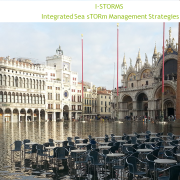
ADAPTING TO CLIMATE CHANGE AND REDUCING THE RISKS OF DISASTERS: THE FIRST results of the I-STORMS project
Nowadays climate change may be driving more frequent and intense extreme weather, and that includes also sea storms. As a result of climate change, future storm events may produce stronger wave action and extreme precipitation, resulting in greater flood impacts and increased coastal erosion. For this reason, the implementation of Disaster Risk Reduction (DDR) policy requires the involvement of several actors and the combination of integrated mesaures. On one hand, scientific knowledge and data sharing are key if we want to prevent potential risks and better cope with emerging ones. On the other one, civil protection agencies and local authorities play an important role in the emergency and recovery phase. Working together at transnational level can prove to be beneficial, especially in similar risk-prone areas where the same challenges are faced and good practices can be shared. To this end, I-STORMS project aims to pull together partners from civil protection authorities, scientific organisations and local municipalities from Italy, Slovenia, Croatia, Albania and Greece to better tackle the risks and the negative effects of sea storm events, combining the expertise and capacities of each organisation.
I-STORMS delivers its first results
The project combines the know-how of environmental and metherological institutions with the on-the-ground experience of municipalities and civil protection agencies dealing with disaster management. I-STORMS developed its first project result through the release of the SEA STORM ATLAS, a tool for coastal disaster mapping. Meanwhile, Italian partners organised the civil protection exercise on sea storm events COSTA 2019, the first of this kind in Italy.
SEA STORM ATLAS
The Atlas provides with risk maps of the ADRION coasts, with the aim of identifying the most vulnerable areas to focus on, thus strengthening common understanding of current challenges. The Atlas is embedded into the platform www.iws.seastorms.eu/maps/165/view. All information on coastal disaster generated by sea storm events (historical and more recent ones) are organised and mapped in geospatial layers which constitute the Sea Storm Atlas. That series can be used to draw the map of risk characterisation of the coast with the aim of identifying the most vulnerable areas and supporting the planning of coastal area.
COSTA 2019
Back to back with the transnational conference of the I-STORMS project, the project organised the civil protection exercise “Costa2019”, the first national simulation on storm risk, with the aim of improving coastal risk management. During the exercise, planned simultaneously in four locations on the Adriatic Riviera – Comacchio, Cervia, Cesenatico and Riccione – the alert procedures and the operational response were tested by all the components of the municipal and regional civil protection system. Project partners outside Italy participated to the exercise as observers. Started on Friday 20 September 2019 with the simulation of an orange color code alert for floods and storm surges, the exercise continued on Saturday 21st with the actions simulated by the alert system’s operational structures and the involvement of civil protection teams.





